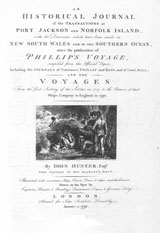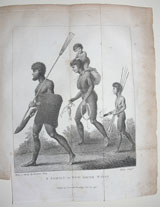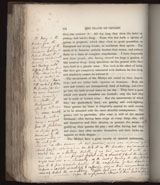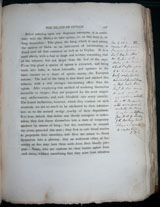During the Romantic period, the market for travel writing soared. The fact that Hunter’s work, exhibited here, was reformatted to appeal to a larger, less affluent readership indicates the desire for materials describing exotic places and equally interesting natives. Hunter’s prose and the engravings used to illustrate it reveal complex attitudes towards foreign lands and their inhabitants—fascination tinged with disgust. In Blake’s engraving there is a sense that the family from New South Wales is on parade for the benefit of the viewer. From a modern perspective, the frontispiece image of Europeans trying to lure a woman out of hiding with a fish seems to challenge notions of what we mean by “civilized.” Percival’s similar narrative—an amalgam of history, geography, and anthropology—describes his observations of what is now Sri Lanka, and Coleridge’s marginalia show him as a reader connecting his own experiences to those of the natives in Ceylon.
Much of the work, like Hall’s engraving, depicts the interaction between the natives and colonizers in the Pacific. Hunter explains that the terrified young woman on the title page, a victim of smallpox, was found hiding in the wet grass. Her condition made her unable to flee when Hunter’s crew arrived.
Engraved by T. Hall from a drawing by J. Hunter.
John Hunter. An Historical Journal of the Transactions at Port Jackson and Norfolk Island.
London: J. Stockdale, 1793.
This octavo abridgement of Hunter’s work contained fewer engravings than the original published in January 1793. Blake’s “A Family of New South Wales” is one of four engravings in the later edition; it had to be folded to accommodate the smaller format of the book.
Engraved by William Blake from a drawing by Governor King.
John Hunter. An Historical Journal of the Transactions at Port Jackson and Norfolk Island.
London: J. Stockdale, 1793.
Coleridge made these notes in 1807 while staying with Thomas Poole, the original owner of the volume. In his marginal comment on page 152, the first of twelve in the book, Coleridge discusses his own experience with “Bang” in relation to Percival’s description of the use of the drug in Ceylon. He described it as “narcotic, with a painful weight from the flatulence or stifled gas occasioned by the morbid action on the coats of the Stomach. In others however it had produced, as we were informed by Sir J. Banks, almost frantic exhilaration.” On page 157 Coleridge makes connections between the Bang of Ceylon and that of Turkey, suggesting that Percival may be misinformed about the drug’s makeup and use.
Marginalia by Samuel Taylor Coleridge.
Robert Percival. An Account of the Island of Ceylon
London: C. and R. Baldwin, 1803
Coleridge made these notes in 1807 while staying with Thomas Poole, the original owner of the volume. In his marginal comment on page 152, the first of twelve in the book, Coleridge discusses his own experience with “Bang” in relation to Percival’s description of the use of the drug in Ceylon. He described it as “narcotic, with a painful weight from the flatulence or stifled gas occasioned by the morbid action on the coats of the Stomach. In others however it had produced, as we were informed by Sir J. Banks, almost frantic exhilaration.” On page 157 Coleridge makes connections between the Bang of Ceylon and that of Turkey, suggesting that Percival may be misinformed about the drug’s makeup and use.
Marginalia by Samuel Taylor Coleridge.
Robert Percival. An Account of the Island of Ceylon
London: C. and R. Baldwin, 1803









